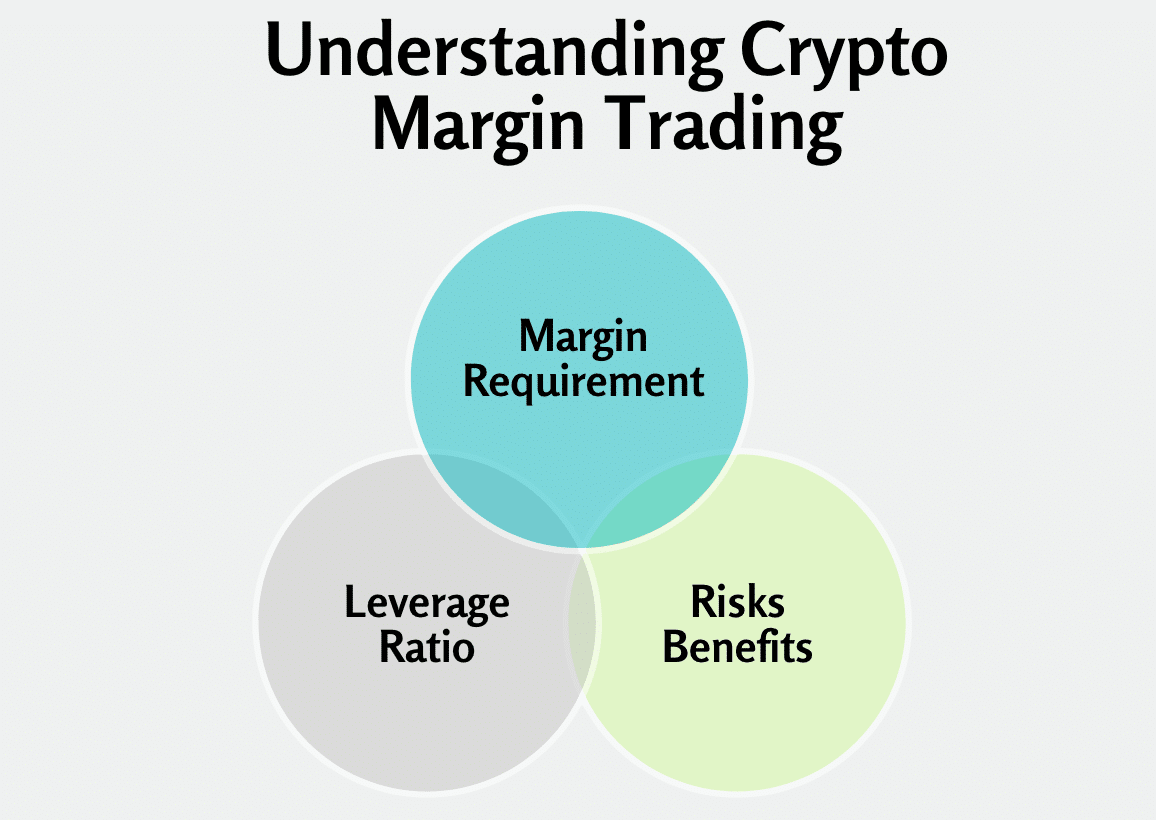Crypto margin trading is often regarded as a high-stakes investment style meant for advanced traders ready to withstand wild price swings with big potential losses and even bigger wins.
Much like in leverage trading, margin traders have to be experts at controlling the risks while pulling the trigger at the right moment to use the volatility to their benefit.
But how exactly does margin trading work in crypto? How does position sizing work? How much money is required to get started, how much does it cost, and what are some of the best strategies?
This and much more will be explained in this beginner guide about crypto margin trading where you will learn the ins and outs of this exciting trading style.
Whether you are a complete beginner learning the basics or perfecting your risk management strategies, read until the end to improve your results and reduce your risk with the expert tips in this article.
Key takeaways
- Crypto margin trading lets you borrow money (leverage) to trade bigger position sizes than you could with just your own cash. This means your gains, and losses, can be much bigger.
- Leverage increases the chances of bigger losses, so use strict a risk management plan. Know your liquidation price (where your broker cancels your position to protect their own capital) and how to handle margin calls when your balance gets too low.
- Crypto margin trading can help you hedge against losses and diversify your strategies. You can also start with a much smaller deposit and aim for higher profits by smartly using leverage.
Crypto margin trading explained for beginners
Crypto margin trading is a strategy that allows traders to increase their position size and potentially boost their trading results using borrowed funds called leverage.
Leverage allows a trader to purchase more cryptocurrency than the original deposit by borrowing funds from the exchange.
To access leverage, traders first have to deposit an initial margin requirement which is usually only a small part of the full trade size, the other part will be the added leverage. Understanding how margin requirement works is important to select the correct margin ratio for your account.
Margin requirements explained:
There are two types of margin requirements you should learn before you start.
- Initial margin: This is the percentage of the total position size that you are obligated to deposit to open a trade. For instance, if an exchange requires a 20% initial margin and you want to trade a position worth $10,000, you’ll need to deposit $2,000 upfront. The remaining $8,000 is borrowed from the exchange.
- Maintenance margin: This is the minimum amount of capital you need to maintain in your account to keep your positions open. It ensures you have enough funds in your account to handle potential losses.
Regularly check your account balance and the market to make sure your positions have enough margin capital.
Crypto margin trading offers a whole set of new opportunities when compared to regular trading where you are trading without leverage.
For example, if you have $1000 in your regular account, this is your trading limit.
However, with margin trading, you can use this $1000 as collateral, or margin requirement, to borrow more money.
It is possible to borrow anywhere from 2x, 5x, 25x, and even up to 200x your initial deposit depending on our experience and risk tolerance.
For example, if you add 5x leverage to your account, your new maximum buying power would be $5000 (5 x $1000 = $5000)
When looking at leverage trading vs margin trading, the fundamentals are the same but each one of the concepts has its uniqueness.
They both work hand-in-hand but fulfill different purposes in how the margin trade is structured.
It’s important to understand how leverage can increase profits and how leverage affects losses before you get started.
How it works in a nutshell
At the foundation, crypto margin trading is a simple concept and traders usually get a grip of how it works after a simple explanation.
To learn more about how to boost your position size with margin and leverage, let’s take a look at how it works:
- Opening a margin account: The first thing you want to do is to open a margin account with a crypto exchange. These exchanges can easily be found online but if you want our recommendations take a look at our review of the most reputable crypto exchanges that offer margin trading. Choose your favorite platform and create an account.
- Deposit your margin capital: Once you have created your account it is time to deposit your margin capital, also called the collateral. This money will act as risk capital when trading and without it, you are not going to be able to access leverage. Most exchanges offer low minimum deposits which lets you start with less risk.
- Access leverage: With your deposit, you can now access leverage from the exchange. Depending on which exchange you have chosen you can choose a ratio between 1:2 up to 1:200 in the margin trading pit or with crypto contract trading. Let’s say that you select 1:10 leverage on your trading platform, this lets you control 10 times more money than your initial deposit.
- Open your trade: Once you have selected your leverage ratio it is time to open the first trade. This is done through the trading interface directly in the chart and you can either choose to buy or short-sell with leverage.
Setting up your margin account is not a complex process, most exchanges even allow KYC-free trading which lets you stay anonymous.
Now, let’s break down how crypto margin trading works using a simple example:
- Getting started: Imagine you’ve got $1,000 in your margin account and you decide to take a risk with 5x leverage.
- Trading: With that leverage, you go ahead and buy $5,000 worth of Bitcoin. Since the initial margin is 20%, your $1,000 is fully used to open this larger position.
- Making a profit: If the price of Bitcoin climbs by 10%, your investment is now worth $5,500. You pay back the $4,000 you borrowed, and you’re left with a tidy profit of $500—that’s a 50% gain on your original $1,000.
- Taking a loss: However, if Bitcoin’s price falls by 10%, the value of your position drops to $4,500. After you return the borrowed $4,000, you’re stuck with a loss of $500, effectively losing half of your initial stake.
You can play around with the numbers yourself.
For example, you might only deposit $500 but instead of 5x leverage, you might want to use 25x leverage.
Take some time to calculate the profits, position sizes, and margin requirements with our margin calculator.
What are the risks? Understanding liquidation and margin call
Crypto margin trading might seem like the perfect trading style for beginners looking to win big with a small account size, however, it is not all sunshine and rainbows.
This coin has two sides and on the other side of profit is risk.
Using leverage is very risky and losses can amount very quickly if you are not prepared.
Most beginner traders make the mistake of “jumping into the pool” without taking a single look at the potential downside.
Margin trading allows you to increase your position size and therefore also increase the potential for loss.
For instance, with 10x leverage, a 1% increase in the market price can translate into a 10% gain in your position. On the flip side, a 1% decline will result in a 10% loss.
This effect is further increased the more leverage you use.
For example, using a leverage of 100x would result in a 100% loss if the market would decline 1% in price.
This would result in a liquidation of your trading account, leaving you with $0 in your balance due to losses that have grown bigger than your initial margin.
When your account gets liquidated, all your margin capital is lost and your trade is canceled.
This is of course a worst-case scenario but it happens every day in the crypto market when beginner traders are not careful.
Before getting liquidated, your exchange will send you a margin call to warn you that you are close to running out of margin capital.
During fast market moves, this can happen very fast, and failing to meet margin requirements could lead to a total loss of your capital.
The best way to avoid this is to always keep track of your liquidation price.
I recommend using our liquidation price calculator before you open your margin trade to know at what level your position becomes vulnerable.
What are the benefits?
The biggest benefits of crypto margin trading such as increased position size and bigger profits are usually what attract new traders.
However, other more subtle benefits, such as hedging and the low entry barrier for smaller accounts also interest crypto traders.
Let’s discuss the most obvious one first, larger profits.
By using leverage, you can access more money than you have initially deposited and this opens up the doors for bigger profits.
A typical market move of 2% in your direction can be amplified 20 times with the use of 1:20 leverage.
Instead of making a profit of $50 in your regular account, with 1:20 leverage your profit would be worth $1000.
Not bad right?
This can propel your profits into a money-making machine if your leverage trading strategies are good enough.
Hedging is also an interesting factor that lets you control your risk when trading the markets.
Hedging means that you take a position in both directions with the same amount to temporarily cancel out the risks.
Think about it, if you have one long position worth $1000 and one short position worth $1000, no matter where the price goes, your account risk is completely mitigated.
This is a common strategy among advanced traders and also one of the main reasons to use crypto margin trading.
Now, the low entry barrier for smaller accounts is also attractive for beginners since it lets them make decent profits even with a small deposit.
Imagine depositing $50 and using 50x leverage.
This would give you a buying power of $2500.
This can be very powerful once you learn how to predict the market consistently.
Final words
Crypto margin trading can be a game-changer if you know how to use it right. By borrowing funds and leveraging your investments, you can amplify your trading power and take advantage of market swings like never before.
In this guide, we’ve broken down the essentials, giving you the tools to understand how to manage leverage, handle margin calls, and maximize your gains while minimizing risks.
Whether you’re new to the game and eager to learn the ropes or an experienced trader looking to sharpen your skills, this article is packed with tips to help you navigate the ups and downs of the crypto market. Get ready to explore the full guide and learn how to use crypto margin trading to your advantage!

